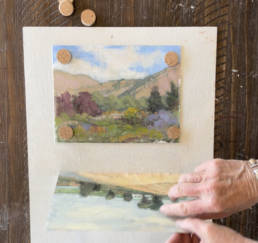Understanding ways to negotiate and set your art prices is skill you must possess before you are ready to take that leap of faith into the professional art world. Being a successful, professional artist not only takes artistic talent, but it also demands solid business sense.
As artists we love the creative aspect of our art careers however, the business side of our art careers can be intimidating. Below, this guest article by my friends at ArtBistro shares some great steps to help you deal with prospective art clients and ways to negotiate and set prices for better art sales and commissions. ~Lori
A visual artist who has had only a moderate number of sales and for whom each sale is a “big event” is likely to have a hard time negotiating higher prices and better deals. Naturally fearful that if he doesn’t accept the proffered amount or deal exactly “as is” that he might well lose the opportunity, he will agree to even outrageous offers, for instance that he take 20% of his usual price or do five paintings for the price of one. I have clients who have been offered precisely these sorts of deals, usually accompanied with the pitch that “being hung in this location will do wonders for your career” or “if you let me have this for a deeply discounted price I’ll send lots of business your way.”
Negotiating is not so much a skill as a feature of the practical, psychological and cultural landscape an artist inhabits. Some people need to drive prices up or down for psychological reasons, because, for instance, they frame everything in terms of winning or losing and to accept a price as offered feels like losing. You see this all the time on the television reality shows, as in the case of the “house flipper” who reflexively demands that every sub-contractor work for less than he or she usually gets. Similarly, the cultural “game” in a flea market is not the same “game” as in a grocery store: at the flea market you bargain, at the grocery store you do not. Do you see the selling of art as more the one or more the other?
Then there are the myriad practical matters that factor into each unique equation: “If I sell this painting for 50% of my usual price, that still pays for my studio space for the next three months, so although I may be doing myself some harm by undercutting my prices, at least I can pay my studio rent.” One artist will refuse to undercut his prices, reckoning that in the long run that is the wisest course; another artist will opt to pay his rent. 
So, first, do not fear losing the deal.
Putting all these important matters to one side, when you do want to negotiate how should you go about doing it?
- First, you want to access that part of you that is not afraid to lose the deal. In fact, you are not at very much risk, as you can always agree to the original price or the original arrangement.
- If a potential collector asks if she pay $1500 for the painting you have priced at $3000, you can take a hard line and say that it is $3000 and that is that; or you can negotiate without any particular risk of losing this sale, as you can always sink to $1500 and “give in.”
- So, first, do not fear losing the deal. Pop a figure out of your mouth that you are comfortable with—in this case, for example, “I can tell how much you love this painting and I really want you to have it, so I am happy to offer it to you for $2500.”
…another aspect of negotiating is to hone your ability to quickly gauge where a negotiation is likely heading
Where do we think this negotiation will go?
- Our life experience tells us that the end point will probably be $2000.
- Next she will say $1750, you will say $2250, and the two of you will settle on $2000.
- So, another aspect of negotiating is to hone your ability to quickly gauge where a negotiation is likely heading, so that you can consider in your own mind whether that end point will feel satisfactory to you or not.
- As soon as she says $1500, you might get in the habit of thinking, “If I counter with $2500 we will probably end up at $2000. Will that be a good outcome?”
- If that feels like a decent-enough outcome, you can allow your $2500 to “sound flexible,” but if you feel that you must stake out $2500 as your end point, then you make it “sound firm.”
I can’t begin to touch on all the possible wrinkles that you might need to take into account at such times, for instance any contractual arrangements you’ve entered into with galleries about holding to your price, the singular importance (or lack of importance) of this buyer to your art life, your sudden, even urgent need for money, and so on. In one situation you may feel it imperative to refuse to negotiate, in another situation you may find yourself negotiating in a friendly and equitable manner, in a third you may feel a lot of internal pressure to accept whatever is being offered. Each negotiation will have its unique psychological, cultural, and practical features.
If I am offered a book advance, I will ask (through my agent) for more and, by asking, almost always get a little extra. If I am asked to speak somewhere and the venue quotes a price lower than my usual speaking fee, I will always come back with a middle-ground figure (unless I actually don’t want to go, in which case I will stand behind my stated fee, which adamancy often prompts the venue to pay my full fee). When I get a book contract to examine, I will ask for six or seven changes—including, for instance, more author’s copies and a higher royalty rate than is being offered—and, as a rough rule, get two or three of them. I can’t recall ever being told, “How dare you negotiate!” It is expected; it is almost always better than just capitulating; and you ought not to fear it, even if you are holding every sale as precious.
If negotiating isn’t in your repertoire of behaviors, practice with a buddy.
If negotiating isn’t in your repertoire of behaviors, practice with a buddy. Have him play the role of a gallery owner offering you a contract or a collector asking for a significant discount. Have him play his role hard, medium, and soft. Try out different responses. See what buttons get pushed in you; get feedback on your negotiating skills; and get better with practice. Add the skill of negotiating to your professional repertoire.
*****
Guest post: Originally posted on ArtBistro.
Have fun and I hope to meet you on Twitter and Facebook!!! ~Lori (If you want to see what I paint, please check out my paintings)
How to Stage Your First Art Exhibition
5 Savvy Tips for Selling Your Art
Commissioned Art – Tips to make it a Success!
10 Tips to Bring Visitors to Your Art Fair Booth or Open Studio











Hi Lori,
Interesting topic. So far I haven’t been in the situation of having to negotiate. People always have been willing to pay the full price that I have set for my artwork. That may lead to my question: maybe my prices are too low?
It’s definitely something I need to look into in more detail since I don’t spend much time on pricing. Thanks for the nudge 🙂
Franziska San Pedro
The Abstract Impressionist Artress
The art collector previously supplied by their favourite art gallery, probably now in receivership, knows that the asking price contained a 50% cut taken by the gallery and the remaining 50% going to the otherwise starving artist. And why is this? Answer; many would-be gallery represented artists took exception to that 50% cut seeing it as a parasite riding on their creativity. They blog this view far and wide, they posted it on art forums etc. And their collectors read it too. Thus the sales income for all artists is now lower than it once was. Lower than it should be. Every artist has now got to negotiate each and every sale from the back foot.
Hello Meltemi-
Being an artist, I of course agree with you for the most part. It is tough to give a big commission to the art galleries nowadays. However, a reputable art gallery works hard for their artists and they deserve their share. I have a negotiated percentage agreement with each of my galleries that I am comfortable with. My galleries advertise, hang my work, send out invitations to my shows, and sell…that is important to me. Each artist needs to take charge of their own career instead of letting the galleries take the reins. Thanks for your valid points to ponder.
Best-
Lori
Maybe we can always charge more than we think? Price definitely is an indicator of value. So if we set the price for our creative work are we also ascribing a value?
Play around with it and see… Try doubling your price and seeing what happens?
If it doesn’t sell you can go down – much harder to go up.
It is yours, you invested your heart and your soul, it’s worth more than you think.
Geoff Talbot
sevensentences.com
I like this bold attitude! This has worked for a few artists that I know. Thanks for another great comment Geoff.
Cheers-
Lori
Love your site. Thanks for sharing all this useful information